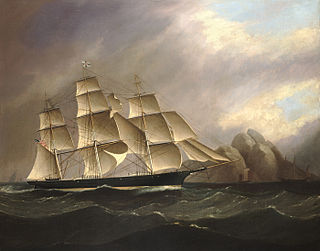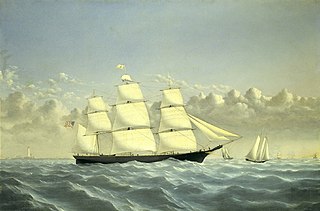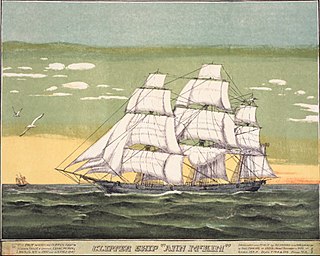
A clipper was a type of mid-19th-century merchant sailing vessel, designed for speed. Clippers were generally narrow for their length, small by later 19th century standards, could carry limited bulk freight, and had a large total sail area. "Clipper" does not refer to a specific sailplan; clippers may be schooners, brigs, brigantines, etc., as well as full-rigged ships. Clippers were mostly constructed in British and American shipyards, although France, Brazil, the Netherlands and other nations also produced some. Clippers sailed all over the world, primarily on the trade routes between the United Kingdom and China, in transatlantic trade, and on the New York-to-San Francisco route around Cape Horn during the California Gold Rush. Dutch clippers were built beginning in the 1850s for the tea trade and passenger service to Java.

Flying Cloud was a clipper ship that set the world's sailing record for the fastest passage between New York and San Francisco, 89 days 8 hours. The ship held this record for over 130 years, from 1854 to 1989.

Marco Polo was a three-masted wooden clipper ship, launched in 1851 at Saint John, New Brunswick. She was named after Venetian traveler Marco Polo. The ship carried emigrants and passengers to Australia and was the first vessel to make the round trip from Liverpool in under six months. Later in her career, the ship was used as a cargo ship before running aground off Cavendish, Prince Edward Island, in 1883.

Red Jacket was a clipper ship, one of the largest and fastest ever built. She was also the first ship of the White Star Line company. She was named after Sagoyewatha, a famous Seneca Indian chief, called "Red Jacket" by settlers. She was designed by Samuel Hartt Pook, built by George Thomas in Rockland, Maine, and launched in 1853, the last ship to be launched from this yard.

Surprise was a California clipper built in East Boston in 1850. It initially rounded Cape Horn to California, but the vessel's owners, A. A. Low & Brother, soon found that the vessel performed well in Far Eastern waters. From that point onward the vessel spent much of her working life in the China trade, although the vessel also made three trips from the East Coast of the United States to California.

The Young America was built by William H. Webb of New York. She was launched in 1853, at the height of the clipper construction boom. She sailed in the California trade, on transatlantic routes, and made voyages to Australia and the Far East.
Harriet Hoxie was an 1851 clipper in the California trade. She was known for carrying cargoes of whale oil from Honolulu, and for importing the first Brown Leghorn chickens to the United States.

Herald of the Morning was one of the few clipper ships with a passage to San Francisco in less than 100 days.

The Memnon was the first clipper ship to arrive in San Francisco after the Gold Rush, and the only clipper to arrive in San Francisco before 1850. Built in 1848, she made record passages to San Francisco and to China, and sailed in the first clipper race around Cape Horn.

Lookout was an 1853 clipper known for her passages from New York to San Francisco, and as an offshore and coastal trader in the lumber and coal trades.

Ocean Telegraph was a clipper ship that was built in Massachusetts in 1854 and was last known of in Gibraltar in 1923. She was in US ownership until 1863, when UK interests bought her and renamed her Light Brigade.

The Blue Jacket was an 1854 medium clipper well known for the lavish decoration of the staterooms and saloon. She served in the Liverpool and Australia trades. The ship was named after the blue jackets, a traditional name for sailors in the US and British navies.

Golden West was an 1852 extreme clipper built by Paul Curtis. The ship had a very active career in the California trade, the guano trade, the coolie trade, the Far East, and Australia. She made a record passage between Japan and San Francisco in 1856.

Golden Fleece was an 1855 medium clipper in the California trade, built by Paul Curtis. She was known for arriving with cargoes in good condition, for making passages in consistently good time, and for catching fire with a load of ice.

Witch of the Wave was a long-lived extreme clipper in the California trade, with a sailing life of over 34 years. In 1851, she sailed from Calcutta to Boston in 81 days, setting a record. It was renamed the Electra in 1871.

The sailing ship Andrew Jackson, a 1,679-registered-ton medium clipper, was built by the firm of Irons & Grinnell in Mystic, Connecticut in 1855. The vessel was designed for the shipping firm of J.H. Brower & Co. to carry cargo intended for sale to participants in the California Gold Rush.

Comet was an 1851 California clipper built by William H. Webb which sailed in the Australia trade and the tea trade. This extreme clipper was very fast. She had record passages on two different routes: New York City to San Francisco, and Liverpool to Hong Kong, and beat the famous clipper Flying Dutchman in an 1853 race around the Horn to San Francisco.

Ann McKim was one of the first true clipper ships. The opening of new Treaty ports in the East in the early 1840s eased an access of the US merchants to China, which demanded the ships that could move cargo faster than then-traditional slow-moving, high-capacity merchant ships. The Ann McKim was one of the ships that had answered the demand in the early years and sailed between New York and China in 1840–1842, until newer and faster cargo-carriers, such as the nearly 600-ton clipper Houqua, the 598-ton China packet Helena, Witch of theWave, and Rainbow, with the last two built expressly to outperform the Ann McKim started dominating the shipping world of the US-China trade and the Ann McKim was shifted back to the South American trade routes.

Hurricane was a large extreme clipper of 1608 tons burthen built in Hoboken, New Jersey, United States in 1851. Reputedly the most extreme clipper ever built, Hurricane proved a very fast vessel, reportedly capable of speeds of up to 18 knots (33 km/h) in ideal conditions, and establishing a number of record passages in the early years of her career.
Santa Claus was an American medium clipper ship built in Boston by Donald McKay in 1854. In the course of her career, she made three voyages from the East Coast of the United States to San Francisco, California, the fastest of which was a comparatively swift 128-day passage in the winter of 1857–1858. The ship was mainly engaged in the guano trade and in trade to the Far East. In 1858, she brought Chinese immigrants to California; according to one source, she was also at one time engaged in the coolie trade.



















